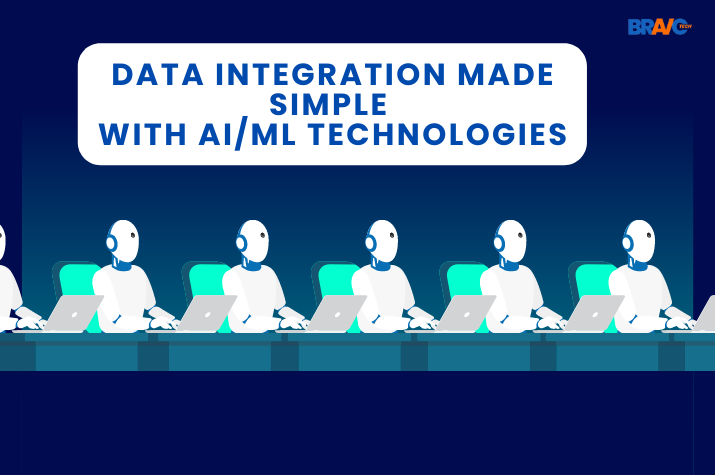Data Integration Made Simple With AI/ML Technology

AI has made doing a lot of things easier. You can find its application in many fields. One of these things that you can do with AI and Machine Learning is data integration. Most of AI and Machine Learning protocols automate all the processes in integration to make it faster and more accurate.
If you want to know the role of AI/ML in data integration, you’ve clicked on the right blog. Here, we will discuss how these algorithms do the complex tasks of effortlessly.
Let’s start
What is Data Integration?
Data integration is the process of combining data from multiple sources into a single, unified view. It can involve anything from transferring data between two databases to consolidating data collected across several disparate sources. By leveraging an open API, ML-driven business sales have access to all relevant customer information in one place, making it easier for organizations to make informed decisions. It simplifies how organizations develop applications and quickly adapt to changing business needs or market trends.
Artificial Intelligence and Digital Transformation
Ultimately, It is all about extracting more value from technological innovations. The most significant way these concepts have been linked to digital transformation is by incorporating Artificial Intelligence (AI) and Machine Learning (ML) into various business strategies.

AI solutions are already being used in businesses across various industries. The reason it is widely accepted is that it is capable of boosting productivity and streamlining key processes. By implementing a solid AI-inclusive digital transformation strategy and data, technology stakeholders can unlock ultimate organizational efficiency and move closer to becoming an ideal data-driven company.
The Challenges of Data Integration for Businesses
Data no longer resides within an enterprise but in the cloud and across multiple systems. The emergence of new data types and formats adds to the diverse data fabric that organizations have in place. As the complexities of big data grow, it will become correspondingly more difficult.
Several data integration tools transport data from one location to another. That, according to most businesses, is the tricky part. However, the reality is quite different. It is challenging to integrate large, complex data streams. Using legacy solutions will take a lot of effort and time; EDl mapping and complex coding will be tasks charged to information technology teams. Tasks like data mapping and data onboarding will take months to complete.
What Does Data Integration with AI/ML Mean?
Integration is linking and transferring data to store it securely for use in running your business and making informed decisions. When you think of data as a car, integration becomes like the road/highway network. If it’s done wrong, there are wrong turns, traffic jams, and frustrations.

You may wonder what this has to do with artificial intelligence (AI) and machine learning (ML). It all comes down to the data. Providing AI and ML technologies with good data training and testing capabilities is the most difficult part of extracting value from these technologies, even though they may sound futuristic and sci-fi. A business with a good integration system with exemplary data flow can improve its data processing through AI and ML. This means that having a sound integration system is beneficial for businesses.
Obstacles to Successful
As businesses continue to count on data, integrating data from streaming data services, relational databases, and other real-time sources has become more complex. Well-architected processes ensure data management, governance, and trust, allowing for the extraction of hidden business intelligence. Attempts at integration can be hampered by
- The challenges of handling data from multiple sources.
- The difficulties of managing various tools
- A business landscape that enables numerous data handlers to access, edit, copy, and duplicate data
- Slow data movement from the cloud and data lakes
How Can AI/ML Simplify the Data Integration Process?
Data Mapping: ML-powered data mapping can automate data transformation with machine learning algorithms by providing advanced features and aiding in agile data mapping predictions. AI also allows users with less technical knowledge to begin the data mapping process with simple drag-and-drop features, reducing the time required to create data mappings.
Data Processing: Traditional data integration tools require a more extended setup and processing time to handle volumes of unstructured data or semi-structured formats, whereas ML-powered data integration tools can parse data and generate precise data models that require less human intervention.Wind-up: AI-infused data integrations solve complex data processing problems and improve integration flow, propelling the business forward and providing a competitive advantage across the enterprise. These cutting-edge integration tools assist enterprises in gaining insights from big data, allowing for better and more timely decision-making and ensuring business competitiveness.
Techniques of Data Integration
1. Traditional Extract Transform and Load (ETL)
ETL is the most common method that involves extracting data from multiple sources, transforming it into a consistent format, and loading it into the target system for analysis or storage.
2. Data Virtualization
Data Virtualization provides an abstraction layer between different data sources and enables seamless access to data without physical integration.
3. Data replication
This technique involves creating multiple copies of data stored in different systems and synchronizing them through regular updates.
4. Application/Data Federation
This technique enables applications to connect directly to individual independent databases and access their combined data without requiring physical integration.
Conclusion
AI and Machine Learning algorithms have made the data integration process a lot easier. These algorithms analyze the complex data so that they can apply relevant protocols in it. In the information that we have just shared with you, some of the important factors in this regard are discussed. You can read them to know how these algorithms help in data integration.





